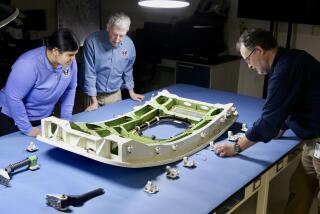Cracks Found in B-2 Bombers
- Share via
WASHINGTON — Sixteen of 21 U.S. Air Force B-2 stealth bombers have cracks as long as nine inches on their specialized skins near the engine exhaust.
Similar cracks showed up during 1990 development testing, and maker Northrop Grumman Corp. and the Air Force thought they had been fixed, said Air Force Secretary James Roche. The service--which said it spent $200 million on patching and design changes--expects the cracks to show up on all the bombers.
The disclosure comes as a new Pentagon report says the bomber spends so much time in maintenance that availability for combat is barely half what it should be.
All this is bad news for congressional supporters who want to reopen Northrop’s Palmdale production line, an analyst said.
“If the Air Force decides it wants to reopen the B-2 line, it will have to prove convincingly to Congress that technology and processes have advanced sufficiently to ameliorate these [maintenance] problems,” said Christopher Bolkcom, a military aircraft analyst for the nonpartisan Congressional Research Service. “It wouldn’t surprise me to see B-2 opponents seize on the crack issue in their attempts to keep the line closed.”
“The B-2 has been overshadowed by the B-1 and B-52 in Operation Enduring Freedom, and Secretary Roche has publicly said he doesn’t support restarting the B-2 line,” Bolkcom said.
The B-2 was Northrop Grumman’s most profitable defense program even as it was cut from 132 aircraft to 75 and then in the early 1990s to 21. Northrop delivered its last B-2 in 2000 when the program generated $750 million in revenue. Chairman Kent Kresa said last year that the company could reopen the line and start delivering the first of 40 additional B-2s by 2006 if the Pentagon approved.
Northrop Grumman’s Integrated Systems Sector makes the bomber. Boeing Co. is the top subcontractor; General Electric Co. produces its engines.
The proposal to reopen the line has some strong supporters in Congress, including Rep. Norman D. Dicks (D-Wash.), who stresses the plane’s ability to fly 30- and 40-hour missions from the U.S.
Dicks pressed his case last week during a hearing of the House defense appropriations subcommittee with the Defense Department’s top acquisition official, Edward “Pete” Aldridge.
Aldridge said the Pentagon’s arguments against reopening the line include the aircraft’s dated, 1980s technology, an ongoing study of developing an unmanned B-3 bomber, and the extensive maintenance it takes to keep the B-2 flying.
A new report from Pentagon Director for Operational Test & Evaluation Thomas Christie says B-2s were available for combat only 31% of the time on average in 2001, a “significant decline” from a 37% rate in 2000. The Air Force standard is 60%.
The B-2’s low rate is caused by “poor reliability and maintainability” from the numerous hours required to restore the bomber’s delicate composite skin after hours of flying and a shortage of qualified maintenance personnel required to do the job. Christie’s report doesn’t mention the cracks.
Northrop Grumman spokesman James Hart said the company is studying the cracks issue. Roche probably will be asked about it today during a House Appropriations subcommittee hearing on the fiscal 2003 budget.
The cracks are worrisome because the Air Force doesn’t know their long-term effect on the B-2 fleet or whether they signify an undiscovered problem with the bomber’s stealth components, analysts said.
The cracks on the $2.2-billion bat-winged bomber are located on the titanium “aft deck” behind the aircraft’s engine exhausts and cockpit.
“The cracks can be seen with the unaided eye,” the service said.
In July, when seven planes had cracks, the Air Force said it applied “containment and prevention techniques” that reduced the occurrence of new cracks and reduced the growth of existing ones. “A long-term solution is in the works,” it said.
Nine more bombers developed cracks after that statement.
Northrop Grumman shares rose $3.07 to $111.82 on the New York Stock Exchange.
More to Read
Inside the business of entertainment
The Wide Shot brings you news, analysis and insights on everything from streaming wars to production — and what it all means for the future.
You may occasionally receive promotional content from the Los Angeles Times.










